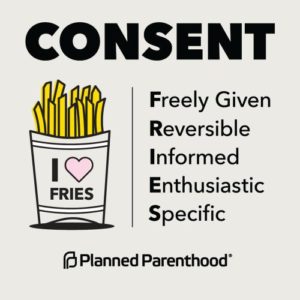
Consent Isn’t Just For the Bedroom
By: Riley Fortier M.Ed.
CW: brief mention of sexual assault
What is Consent?
Consent in its most basic definition is the discussion and implementation of boundaries. Consent is about communication. Most commonly, people associate consent with sex, which is great! Consent is a huge part of sexuality. For example, asking your sexual partner questions like, “Would it be okay if i kissed you?,” “Do you want to head upstairs now?,” or “Can I touch you here?” are all ways to ask for consent.
On the other hand, receiving consent and upholding the other person’s boundaries is often overlooked. For example, if someone asks to stop or pause the sexual activity going on in the moment, it is also your job as the recipient of that to follow through and honor what they just asked of you. It is not enough to just ask for consent, you must also be prepared to receive it.
However, consent expands to much more than that. Without even realizing it, you are likely asking and giving consent in your everyday life.
Sexual consent
Most people associate consent with sexual activity. Asking to switch positions, to touch a different area of the body, to stop or pause the current sexual activity are all examples of consent. Both vanilla (i.e. non-kinky) and kinky sex or BDSM practices utilizes consent as a core practice.
Consent is an ongoing process and conversation and can be withdrawn at any time. Planned Parenthood uses the “FRIES” explanation for consent, which is outlined below:
F freely given – the person is giving consent without any pressure from other people or external factors. It is their own decision.

Source: Planned Parenthood
R reversible – consent can be withdrawn at any time. Consenting to something at first and then realizing you want to stop or change.
I informed – Both parties are aware of risks associated with the activities you agreed upon
E enthusiastic – A clear and enthusiastic “yes!” A “maybe” or “sure” should be taken as a no.
S Specific – Saying yes to one thing does not mean you are also saying yes to another.
Cycling Through Consent
Another way to think about consent is riding a bicycle, shown through this video below:
Things like arousal, natural lubrication, erection, and even orgasm are physiological, and are sometimes involuntary, and these ALONE should not be taken as consent. Someone’s body may react one way while their mind is reacting a different way, and that’s okay and valid, and it doesn’t mean that person was consenting or “asking for it.”
It’s important to note that the LEGAL definition of sexual consent depends on each state’s laws when it comes to sexual assault. You also cannot give consent if you are under the influence of drugs and alcohol to the point where it affects your decision-making skills, or if you are unconscious.
If you’ve experienced sexual assault, you’re not alone. To speak with someone who is trained to help, call the National Sexual Assault Hotline at 800.656.HOPE (4673) or chat online at online.rainn.org.
Consent in everyday life
Consent is for both the wellbeing of your mind, but also the wellbeing of your body. An example of physical consent in everyday life could be when you’re saying goodbye to your friend and they ask, “is it okay if I give you a hug goodbye?” If your answer is yes, then great! You just gave consent for a hug. If your answer is no, then that’s also great! You upheld your boundary and instead maybe you could offer a wave or fistbump instead.

Source: Priscilla duPreez via Unsplash
Non-sexual consent in everyday life is also super important when it comes to teaching children about their bodies and the rights to their own bodies. Something as simple as asking a child, “can I have a hug?” is an example of asking consent. Sometimes they will say no, and that’s okay. It doesn’t mean they don’t love you, it just means they don’t want to give you a hug right at that moment.
Emotional consent is also another aspect of everyday consent. Asking your friend, “Would it be okay if I complain about this thing that happened at work today?” is an example of emotional consent. You’re asking your friend if they have the emotional space to receive that kind of information instead of just jumping right into it. If they say yes, then great! Go for it. If they say no or seem unsure, see if there is someone else you could go to to get that need met, or maybe that means your therapist or that means journaling about your day instead.
Why is this important?
Everyone is entitled to their own emotional and physical space and safety! Asking for consent, continually checking in, and supporting other’s boundaries are great ways to practice that. Additionally, it’s also a great way to model bodily autonomy for others.
Consent can be sexy, but it doesn’t have to be! It can be logistical, and that’s okay!
How will you implement more explicit forms of consent in your daily life?
Resources
https://www.rainn.org/national-resources-sexual-assault-survivors-and-their-loved-ones
https://www.plannedparenthood.org/learn/relationships/sexual-consent











